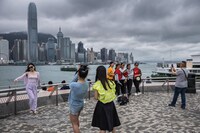Young people in China call themselves ‘special forces’ of budget travel
5 min read
HONG KONG — A steady stream of young Chinese tourists stops by a seaside cafe in Hong Kong’s Kennedy Town to take pictures of the harbor — but only for a moment.
Many are on a city walk recommended on the short video app Xiaohongshu, China’s answer to Instagram, as a way to rush between picture-ready — and free — destinations among the soaring skyscrapers and lush mountainsides of the otherwise pricey Asian financial hub.
The young people who are trying to get as much bang for their buck while on holiday during these difficult economic times have come to be known as “special forces” travelers because they push themselves to the limit with packed itineraries and extreme cost-cutting.
Budget-conscious travel is all the rage for Chinese tourists taking advantage of the long holiday that begins on Friday with the Mid-Autumn Festival and runs into National Day commemorations.
This week, Chinese workers get eight consecutive days of leave — think summer holidays in Europe or the United States — and it is being watched closely by analysts to see whether consumers are spending again and if the world’s second-largest economy is shaking off its post-pandemic malaise.
Nine months after Beijing suddenly abandoned its strict “zero covid” policies, Chinese tourists are gradually returning. But lingering concerns about a slowing economy mean they are more likely to spend less and pick destinations closer to home, analysts said.
Lavish spending by Chinese travelers has long been a driving force for international tourism. The country’s newly minted middle class has led the world in outbound travel since 2012, and sales of designer handbags, luxury watches and other high-end goods have been propped up by China’s uber-rich on overseas shopping sprees.
That kind of holiday is a long way from Lynn Chen’s mind. The 25-year-old engineer, who works in Beijing, decided to get a jump-start on her vacation to save money and came to Hong Kong ahead of the main travel rush. She is shunning the city’s ticketed tourist destinations in favor of a few days walking about, soaking up the atmosphere.
Even if the economy is in rough shape, Chen and her friends still think it’s better to get out and spend — just to be more cautious when they do so. If she goes anywhere next week, it will be within mainland China, and she’ll probably stay with friends.
“My elders tell me that because the current economic situation is not good you should save and not spend money randomly,” she said. “But my friends or colleagues conversely say that the pandemic has made them want to enjoy life more.”
Chinese state media has touted record numbers of high-speed rail bookings as evidence that the recovery is on track. What’s less clear is whether these tourists will spend as much on their trips as they did before the pandemic.
During China’s last major public holiday in May, more trips were taken by travelers than in the same period in 2019, before the pandemic, but individuals spent less on average, according to official data.
And uncertainty over China’s economic outlook is leading experienced travelers to put off trips abroad, with almost 40 percent of them saying they plan to wait two years before going overseas again, a recent survey by Oliver Wyman, the management consulting firm, found.
“While the Chinese travelers are returning, it [has taken] longer than we expected when the border reopened,” Imke Wouters, a partner at Oliver Wyman who led the research, said in the report.
“Traveling domestically is much more of a budget option,” and lower consumer confidence is pushing Gen-Z travelers toward spending on experiences like camping, road trips and hiking instead of big ticket items, said Allison Malmsten, an analyst from market research firm Daxue Consulting.
Many in the international tourism industry had hoped that the end of the pandemic would unleash a wave of pent-up “revenge spending” from Chinese travelers unable to go overseas during nearly three years of strict coronavirus border controls.
But this year’s anticipated rebound has been weaker than many expected — and heavily weighted toward travel within China.
Another survey released this month by market research firm Mintel found that domestic tourism is back as a top priority for Chinese consumers but warned that “large-scale spending increases are still unlikely, as saving is more of a priority given the various uncertainties consumers are facing.”
To take advantage of the moment, the report’s authors advised, businesses need to provide “instant relaxation or indulgence with small-ticket spending.”
While seeing the world on a budget isn’t new, the desire to have fun while still saving has led to an apparent spike in the popularity of shoestring travel, especially among younger Chinese tourists.
The troops of “special forces” travelers are mostly college students and young professionals who take pride in going to extreme lengths to hunt down bargains and cram their limited vacation time with as many social-media worthy stops as possible — even if that comes at the expense of personal comfort.
They scour Xiaohongshu, China’s go-to platform for travel tips, for unconventional but picturesque — and, most importantly, cheap — places to visit.
They shun expensive shopping malls and sleep in internet cafes or in cars, prefer a free city walk to a paid tour, and might opt to visit a museum or other site virtually instead of paying for real-life entry.
Rex Gu, a 27-year-old native of Nantong in eastern China, was visiting Hong Kong this week and considers himself a travel commando.
After months of searching for cheap tickets and accommodation, his trip has been a whirlwind of stops in several Southeast Asian countries before visiting Hong Kong for three days. Next week, during the busiest period, he plans to hit up the famous West Lake of Hangzhou city, which isn’t far from his hometown — and is free to visit.
The approach isn’t for everyone, Gu said, but he personally finds it fulfilling. “Although I am in a hurry, I feel that’s okay. Your body is very tired when you walk, but you are not tired inside.”



